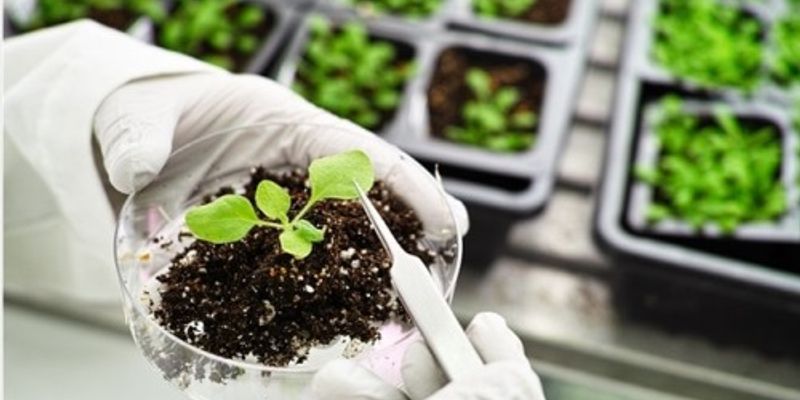Plant Metabolomics
Plant Metabolomics: help to understand plant biology and physiology from the perspective of small chemical molecules. The aspect of metabolomics has found its way in plant biotechnology, transgenic research, improved tolerance to stress, and plant breeding.
-
SEP 14, 2021 | 7:00 AMDate: September 14, 2021 Time: 7am PDT, 10am EDT, 4pm CEST A conventional thermal cycler has long been a commodity product in the lab and end-point PCR techniques can be completed almost wit...MAY 11, 2021 | 10:00 AMDate: May 11, 2021 Time: 10:00zm PDT Your samples are some of the most valuable assets in the laboratory. After spending countless hours on extraction and preparation, your conclusions could...Speaker: Paulina Kocjan , Kate Meola , Zareh ZurabyanFEB 24, 2021 | 10:00 AMDATE: February 24, 2021 TIME: 10am PST Automated lab instruments such as liquid handlers and cell sorters are increasingly common in all types of laboratories, driving fast results for labor...DEC 02, 2020 | 8:00 AMDATE: December 2nd, 2020 TIME: 08:00am PDT, 11:00pm EDT Bioreactors and shakers are used to cultivate microorganisms, plant, insect, and mammalian cells in different volumes. Upscaling of pr...SEP 09, 2020 | 12:00 AMTraditionally, virology has been focused in studying the pathogenic effect of viruses. In the recent years, however, this perception is changing and viruses are being studied as mutualistic...MAY 06, 2020 | 12:00 AMThe necrobiome is the community of organisms that use or are affected by decomposing organic matter. Decomposing organic matter comes in the form of dead plant matter (biomass) or that of de...MAR 25, 2020 | 6:00 AMHousehold produce varieties such as ‘Red Delicious,’ ‘Campari,’ and ‘Earlidew’ have been selectively bred and have been enhanced for flavor since the 1990...MAR 25, 2020 | 12:00 AMEvery cannabis variety has unique genetics, but the plant's potential is limited by its environment. Manipulating inputs and modifying the environment is the most effective way to maximi...SEP 12, 2019 | 9:00 AMPlants recruit soil microbes that provide nutrients, promote growth and protect against pathogens. However, the full potential of microbial communities for supporting plant health and agricul...MAR 28, 2019 | 12:00 PMWhole food plant-based diets and medical cannabis have shared and continues to share similar levels of scrutiny, doubt, and stigma by the traditional medical community. One reason for the med...SEP 13, 2018 | 12:00 PMThe greatest need in agriculture this century is to mitigate impacts of abiotic (drought, temperature, salinity) and biotic (pathogens, pests) stresses on crop plants. Efforts over the...SEP 13, 2018 | 10:30 AMThe bacterium Pantoea stewartii subsp. stewartii causes Stewart’s wilt disease in corn and serves as a model for other xylem-dwelling phytopathogens. P. stewartii is transmitted to plan...SEP 13, 2018 | 9:00 AMViruses outnumber bacteria in soil by as much as 1000:1. However, there are few studies which examine the ways viral communities impact the soil microbiome, chemical cycles, and plants. Recen...MAR 29, 2018 | 6:00 AMAnalysis of pesticides in cannabis is essential to protect the public health, especially medical cannabis patients. Sensitive and selective measurement is required in order to provide confide...SEP 28, 2017 | 9:00 AMContractile non-muscle cells, including smooth muscle and myoepithelial cells, provide the mechanical forces required for tissue homeostasis in numerous organ systems. For example, smooth mus...SEP 14, 2017 | 1:30 PMPlant viruses cause significant damage in terms of reduction in quality and quantity of yield in a wide range of crop plants worldwide. The majority of plant viruses are transmitted from one...SEP 14, 2017 | 6:00 AMA rapidly growing number of viruses of lower eukaryotes have been reported in the past few decades. These have enhanced our understanding of virus evolution and diversity. Simultaneously, som...SEP 13, 2017 | 9:00 AMVirus – host interactions are currently among the most intensively studied research areas due to the promising new antiviral approaches emerging from these studies. Indeed, RNA viruses,...SEP 08, 2016 | 12:00 PMVirus Ecology is a field that is gaining momentum, fueled in part by metagenomic studies from many environments previously ignored. Biodiversity studies of plant viruses show that they...SEP 08, 2016 | 9:00 AMME/CFS is a debilitating disease with a controversial history and multiple names. The Institute of Medicine recently recommended renaming the disease “Systemic Exertion Intoleranc...SEP 07, 2016 | 10:30 AMThe human body is populated with trillions of microorganisms, collectively termed the human microbiome, that play vital roles in health including nutrition and metabolism, immune development,...SEP 07, 2016 | 6:00 AMThe human race, like all macrobiological life, evolved in a sea of microbes. There was no way to keep the bacterial and archaeal hoards at bay, so instead life evolved mechanisms to live with...SEP 17, 2015 | 8:00 AMDespite recent developments in hyphenated techniques and column technology, analysis of small polar analytes (small organic acids, phosphorylated sugars, and underivatized amino acids) remain...SEP 02, 2015 | 12:00 PMPolyamines are small, mostly linear organic molecules found in almost all living cells, and are positively charged at physiological pH. As a consequence of their positive charge, polyamines b...
SEP 14, 2021 | 7:00 AM
Date: September 14, 2021 Time: 7am PDT, 10am EDT, 4pm CEST A conventional thermal cycler has long been a commodity product in the lab and end-point PCR techniques can be completed almost wit...
MAY 11, 2021 | 10:00 AM
Date: May 11, 2021 Time: 10:00zm PDT Your samples are some of the most valuable assets in the laboratory. After spending countless hours on extraction and preparation, your conclusions could...
Speaker:
Paulina Kocjan
, Kate Meola
, Zareh Zurabyan
FEB 24, 2021 | 10:00 AM
DATE: February 24, 2021 TIME: 10am PST Automated lab instruments such as liquid handlers and cell sorters are increasingly common in all types of laboratories, driving fast results for labor...
DEC 02, 2020 | 8:00 AM
DATE: December 2nd, 2020 TIME: 08:00am PDT, 11:00pm EDT Bioreactors and shakers are used to cultivate microorganisms, plant, insect, and mammalian cells in different volumes. Upscaling of pr...
SEP 09, 2020 | 12:00 AM
Traditionally, virology has been focused in studying the pathogenic effect of viruses. In the recent years, however, this perception is changing and viruses are being studied as mutualistic...
MAY 06, 2020 | 12:00 AM
The necrobiome is the community of organisms that use or are affected by decomposing organic matter. Decomposing organic matter comes in the form of dead plant matter (biomass) or that of de...
MAR 25, 2020 | 6:00 AM
Household produce varieties such as ‘Red Delicious,’ ‘Campari,’ and ‘Earlidew’ have been selectively bred and have been enhanced for flavor since the 1990...
MAR 25, 2020 | 12:00 AM
Every cannabis variety has unique genetics, but the plant's potential is limited by its environment. Manipulating inputs and modifying the environment is the most effective way to maximi...
SEP 12, 2019 | 9:00 AM
Plants recruit soil microbes that provide nutrients, promote growth and protect against pathogens. However, the full potential of microbial communities for supporting plant health and agricul...
MAR 28, 2019 | 12:00 PM
Whole food plant-based diets and medical cannabis have shared and continues to share similar levels of scrutiny, doubt, and stigma by the traditional medical community. One reason for the med...
SEP 13, 2018 | 12:00 PM
The greatest need in agriculture this century is to mitigate impacts of abiotic (drought, temperature, salinity) and biotic (pathogens, pests) stresses on crop plants. Efforts over the...
SEP 13, 2018 | 10:30 AM
The bacterium Pantoea stewartii subsp. stewartii causes Stewart’s wilt disease in corn and serves as a model for other xylem-dwelling phytopathogens. P. stewartii is transmitted to plan...
SEP 13, 2018 | 9:00 AM
Viruses outnumber bacteria in soil by as much as 1000:1. However, there are few studies which examine the ways viral communities impact the soil microbiome, chemical cycles, and plants. Recen...
MAR 29, 2018 | 6:00 AM
Analysis of pesticides in cannabis is essential to protect the public health, especially medical cannabis patients. Sensitive and selective measurement is required in order to provide confide...
SEP 28, 2017 | 9:00 AM
Contractile non-muscle cells, including smooth muscle and myoepithelial cells, provide the mechanical forces required for tissue homeostasis in numerous organ systems. For example, smooth mus...
SEP 14, 2017 | 1:30 PM
Plant viruses cause significant damage in terms of reduction in quality and quantity of yield in a wide range of crop plants worldwide. The majority of plant viruses are transmitted from one...
SEP 14, 2017 | 6:00 AM
A rapidly growing number of viruses of lower eukaryotes have been reported in the past few decades. These have enhanced our understanding of virus evolution and diversity. Simultaneously, som...
SEP 13, 2017 | 9:00 AM
Virus – host interactions are currently among the most intensively studied research areas due to the promising new antiviral approaches emerging from these studies. Indeed, RNA viruses,...
SEP 08, 2016 | 12:00 PM
Virus Ecology is a field that is gaining momentum, fueled in part by metagenomic studies from many environments previously ignored. Biodiversity studies of plant viruses show that they...
SEP 08, 2016 | 9:00 AM
ME/CFS is a debilitating disease with a controversial history and multiple names. The Institute of Medicine recently recommended renaming the disease “Systemic Exertion Intoleranc...
SEP 07, 2016 | 10:30 AM
The human body is populated with trillions of microorganisms, collectively termed the human microbiome, that play vital roles in health including nutrition and metabolism, immune development,...
SEP 07, 2016 | 6:00 AM
The human race, like all macrobiological life, evolved in a sea of microbes. There was no way to keep the bacterial and archaeal hoards at bay, so instead life evolved mechanisms to live with...
SEP 17, 2015 | 8:00 AM
Despite recent developments in hyphenated techniques and column technology, analysis of small polar analytes (small organic acids, phosphorylated sugars, and underivatized amino acids) remain...
SEP 02, 2015 | 12:00 PM
Polyamines are small, mostly linear organic molecules found in almost all living cells, and are positively charged at physiological pH. As a consequence of their positive charge, polyamines b...
























